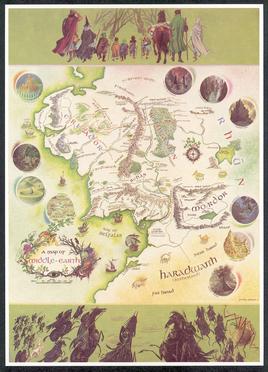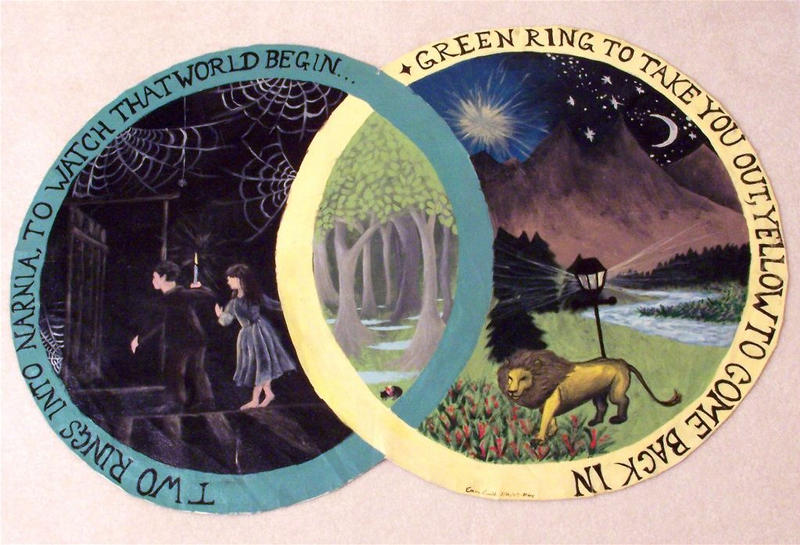It probably won't come as a surprise to you that Tolkien's creation story for Middle Earth, "Ainulindale," and
C.S. Lewis' novel about the beginning of Narnia, The Magician's Nephew closely resemble each other. Like many creation myths, both Narnia and Middle-earth start out in a sort of 'nothingness' and both tales explain how the material and spiritual world come into being.
But both Tolkien and Lewis are particularly interested in the presence of evil during creation and especially the presence of music during creation. For both Narnia and Middle earth are sung into creation and music and harmony play an essential role in their worlds.
There are, however, important differences in each creation story. As the narrator in The Magician's Nephew is quick to point out, “For what you see and hear depends a good deal on where your standing” (125). Although there are clear similarities in the way each author describes his world's creation, there is an important and fundamental difference in “where one is standing” in each text. Tolkien's “Ainulindale” places the reader among Illuvatar and the Ainur, and internal growth within the world's creators plays a significant role. In Lewis' The Magician's Nephew however, the reader is placed alongside Digory and Polly who visit Narnia as outsides and are thus external to its creation.
From the start of Tolkien's “Ainulindale” we are invited to learn more about Middle Earth's creators than Middle Earth itself. The Ainur's music is ultimately revealed to be the world “foreshadowed and foresung”(20), but “Ainulindale” is largely about the Ainur's experience of creating the music. Unlike The Magician's Nephew, which describes the harmonious singing and Narnia's creation as “two wonders happen[ing] at the same moment” (99), Middle Earth (both the vision and the tangible world) is not revealed to the Ainur until they have a deeper understanding of themselves and of Illuvatar. It is clear that they must first grow together through music and learn more than “that part of the mind of Illuvatar from which he came” (15). As they do so, they are described as coming “to a deeper understanding, and increas[ing] in unison and harmony” (15). This harmonizing is integral to the creation of the world, for it is only after this initial music that Illuvatar begins to “declare to them a mighty theme, unfolding to them things greater and more wonderful than he had yet revealed” (15). Middle Earth's creation is thus founded in a growing knowledge of Illuvatar.
Narnia, however, is fundamentally different than Middle Earth in that it is but one world among many. As such, Digory and Polly themselves are external to it. Unlike the Ainur who come to know much of illuvatar and are told much of “what is, what was, and is to come” (18) in the world, the children and their party enter Narnia quite literally in the dark. They do not take an active part in creating Narnia, but rather hear a voice singing that “seemed to come from all directions at once” (98) and watch as “a thousand, thousand points of light leaped out” (99). Illuvatar may have direct contact with the Ainur before Middle Earth is created, but Aslan lets the children witness Narnia's creation from the outside, revealing himself only after the world of Narnia takes shape. This has two effects that are very different from what we see in “Ainulindale:"The first is that unlike the Ainur, the children can see that Narnia is being brought to life with music. For, just as the singing voice creates “the mightiest and most glorious sound it had yet produced, the sun arose” (101).
The second effect is the feeling evoked when the children first see Aslan. The narrator describes, “The earth was of many colours: they were fresh, hot, vivid. They made you feel excited; until you saw the Singer himself, and then you forgot everything else” (101). We are not asked to come to know Aslan first and feel closer to him because of his creation (as the Ainur feel closer to the mind of Illuvatar after seeing the vision for his Children). But instead to see Narnia first in order to more easily recognize Aslan's magnificence and power.
Digory and Polly not only learn of Aslan and Narnia differently than the Ainur learn of Illuvatar and Middle Earth, but they have an equally different experience with the creation of evil. The children expose Narnia to evil by bringing in Jadis. But in “Ainulindale” the evil of Melkor is weaved within the creation of the world itself. As the music progresses, Melkor seeks “to increase the power and glory of the part assigned to himself” (16), creating immediate discord among the Ainur. Illuvatar allows for within its very conception.
Melkor to sing and does not directly stop the discord from “spread[ing] ever wider” (16). Jadis embodies a similar evil from the outset of the novel, but once she enters Narnia, it is clear Aslan feels that he must protect Narnia from her, and that it is “Adam's race that has done the harm”(137), suggesting that Jadis does not belong in Narnia at all. Illuvatar, however, does not try to eliminate Melkor altogether. Rather he combats Melkor with his own second and third theme, knowing that in doing so he not only creates a music that “ gathered power and had new beauty” (16), but actively blends evil into the creation of the world. The two musics of the third theme is illustrative of this: as the loud, vain, and unharmonious music gains volume against the beautifully somber one, its “most triumphant notes were taken by the other and woven into its own solemn pattern” (17). Evil is thus not brought into Middle Earth as Jadis is brought to Narnia, but is brewed within its very conception.





